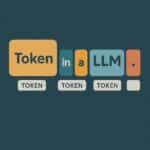Understanding what a token in LLM is can clarify how large language models process and generate text. Tokens are the building blocks that LLMs use to interpret and produce human language.

What Is a Token?
In the context of an LLM, a token is a unit of text used during training and inference. Tokens can be:
- Words
- Subwords
- Characters
For example:
- “ChatGPT is great” → might tokenize to [“Chat”, “G”, “PT”, ” is”, ” great”]
The exact tokenization depends on the tokenizer used (e.g., Byte-Pair Encoding).
Why Tokens Matter in LLMs
1. Token Count Limits
LLMs have a maximum number of tokens they can handle per input (e.g., 4,096 or 32,000). Exceeding this limit means truncation or errors.
2. Tokenization Affects Understanding
How a sentence is split into tokens affects how well the model understands context and semantics.
3. Performance and Cost
Most LLM APIs charge based on token count, making token efficiency important for cost and speed.
Types of Tokenizers
- Whitespace Tokenizer: Splits on spaces
- Subword Tokenizer: Breaks words into sub-parts (e.g., BPE, WordPiece)
- Character Tokenizer: Treats each character as a token
Modern LLMs use subword tokenizers for efficiency and flexibility.
Internal and External Resources
Explore more: [How Embeddings Work in NLP]
Trusted sources:
Conclusion
A token in LLM is a core concept that influences how models interpret, generate, and charge for content. Understanding tokens helps optimize prompts, control costs, and improve performance.
CTA: Curious about prompt engineering? Start by understanding tokenization—it’s the foundation of every prompt!
FAQ: Token in LLM
What is a token in LLM?
A token is a unit of text used by LLMs to process and generate language, such as a word or subword.
How many tokens can an LLM handle?
It varies by model—common limits are 4,096, 8,192, or 32,000 tokens.
Why do tokens affect cost?
Many LLM APIs bill users based on the number of input and output tokens.


Leave a Reply